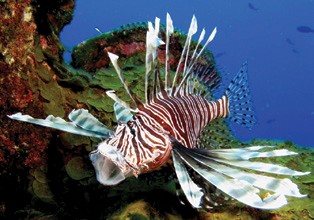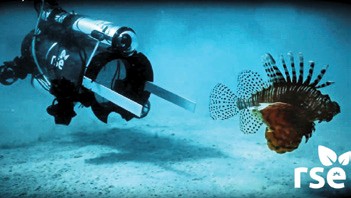 A non-profit organization called Robots in Service of the Environment (RSE) has developed a robot that will hopefully be the solution to what many experts have described as the worst man-made ecological disaster ever witnessed. The problem is a massive invasion by the lionfish, a voracious predator that threatens to destroy coral reef ecosystems, native fish stock and fisheries in the Caribbean Sea, Western Atlantic and Gulf of Mexico.
A non-profit organization called Robots in Service of the Environment (RSE) has developed a robot that will hopefully be the solution to what many experts have described as the worst man-made ecological disaster ever witnessed. The problem is a massive invasion by the lionfish, a voracious predator that threatens to destroy coral reef ecosystems, native fish stock and fisheries in the Caribbean Sea, Western Atlantic and Gulf of Mexico.
Lionfish are ravenous omnivores that will eat any fish or invertebrate that fits into their gaping mouths. ©FGBNMS/A. Sterne
The first reported sighting of a lionfish on the East Coast of the United States was in Florida in 1985, and they’ve been found as far north as New Jersey, New York and Rhode Island. Lionfish are popular with saltwater aquarium enthusiasts, and it is believed that that some of these people released them into the waters of the Atlantic and Caribbean when they had outgrown their tanks. In their native ranges of the Pacific Ocean, Indian Ocean and the Red Sea, lionfish populations are kept in check by natural predation. Because they are armed with 18 spines that can inject venom into any larger fish that attempts to eat one, however, lionfish have no natural predators in our part of the world.
Lionfish are out-breeding, out-competing and out-living native fish and other marine species, and their population density in the Western Atlantic is 17 times greater than their natural habitat in the Pacific. Lionfish reach sexual maturity in 12 months and can live up to 30 years, and one fish is capable of spawning 30,000 to 40,000 eggs every three to five days. They are indiscriminate predators that can eat prey up to one half of their body length, and they’re known to gorge on at least 70 different species. These include commercially important fish such as juvenile snapper, grouper and flounder; recreationally important fish such as juvenile billfish, mahi mahi, wahoo, jacks and tuna; crustaceans including lobster, crabs and seahorses; and “cleaners” –small fish and shrimp that keep bigger fish healthy by removing parasites and other disease causing organisms, and grazing creatures that keep the reef free of algae and other growth that would otherwise smother it. A single lionfish can reduce the fish biomass on a reef by 80 to 90 percent in just one month!

Designed for use by non-professional operators, RSE’s Guardian LF1 finds lionfish, delivers a low-voltage electric shock, and captures them for harvesting on the surface. © robotsise.com
Fortunately, a solution may be at hand. RSE’s Guardian LF1 undersea robot is an affordable device that locates, stuns and captures lionfish. Designed for use by non-professional operators, the Guardian LF1 is tethered to a remote control station on the surface. The operator uses the remote control to a find a lionfish, and then activates a low-voltage current to stun it and suck it into the device. A single LF1 can capture and hold up to 10 lionfish before returning to the surface.
A prototype of the LF1 made its debut during the 35th America’s Cup in Bermuda, where it was tested to harvest lionfish from the island’s reefs ahead of the #EatLionfish Chefs’ Throwdown. This inaugural event was organized by 11th Hour Racing, a Newport, RI-based program of The Schmidt Family Foundation that establishes strategic partnerships within the sailing and marine communities to promote collaborative systemic change for the health of our marine environment. Each of the six America’s Cup teams was represented by a top chef competing to create the best lionfish dish, and the contest was judged by representatives of the Cup teams.
The Throwdown, conceived to determine who had the tastiest solution to the problem of invasive lionfish, was emceed by chef Rick Moonen of RM Seafood in Las Vegas, NV a strong advocate for sustainable fishing practices and eating lionfish. “It’s a great filet…white buttery meat, heart-healthy, like Dover sole,” said Moonen. “It’s more neutral…I like to brine or cure it a little. It fries really well.” The winning chef was Land Rover BAR’s representative Chris Kenny, head chef on Sir Richard Branson’s Necker Island, BVI, who prepared lionfish ceviche, lionfish & chips, and lionfish curry. “These chefs are passionate about sustainability,” said Todd McGuire, 11th Hour Racing’s Program Director.
RSE, headquartered in Massachusetts, continues developing the Guardian LF1 and is testing it in the waters off Bermuda and Florida with a goal of fine-tuning it for multiple markets. “Consumers, dive operators, commercial fishermen…we’re after lots of people catching lots of fish,” explained RSE Executive Director John Rizzi.
According to the Bermuda Underwater Exploration Institute, the only way to beat lionfish is to eat them. The good news is that lionfish meat is flaky and delicious. Lionfish is on the menu in a growing number of restaurants in Bermuda, Florida and elsewhere, and it’s available at select Whole Foods Markets. When you eat lionfish, you help prevent the spread of invasive species and you help protect native ecosystems. Buon appetito! To learn more, log onto team11thhourracing.com/eatlionfish.
